
Brownie Resources

 |
Brownie Resources
|
 |
Tudors
Tudor craftsGames
Tournament
on the Field of the Cloth of Gold
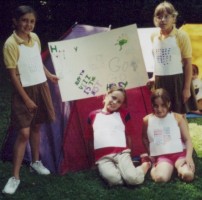 At the start of the tournament Henry VIII welcomes all the knights to 1520 and the Field of the Cloth of Gold. He explains that they are hear to demonstrate their knightly valour. Each six is shown to their tent. The Brownies cut out an armour shape from card, decorate it with their six shield and then attach it using elastic. Each six then has until the end of lunch to decorate their tent however they see fit. After lunch Henry VIII judges which tent best befits a member of the Royal Court and then the tournament begins. 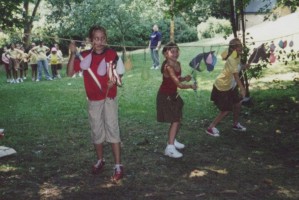  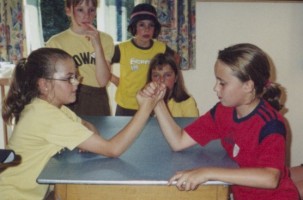 Round 1: Testing Swordsmanship. As a
relay each Brownie rides a hobby horse up to a string of water filled
balloons. Using a plastic sword they must burst a balloon and then ride
back to the next member of their six.
Round 2: Weight lifting. Brownies lifted light weights. They were given points not only for lifting the weights but for doing so safely. (This activity was preceded by a discussion on the correct way to lift heavy objects.) Round 3: Arm wrestling. Each six practised amongst themselves and then nominated two champions to compete against the other teams. Winners played winner until there was only one victor.  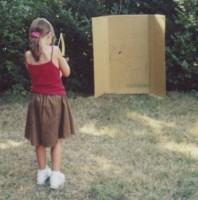  Round 4: Testing our knights aim with
a game of bowls.
Round 5: Field archery using a toy bow and arrow. Bonus round: The falconer rushes in to say that all the birds have escaped. Knights must recapture as many birds as possible (hidden as pictures stuck on card around the site).  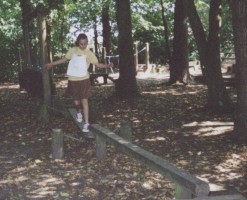 Round 6: Testing how steady your hand
is. A relay race in which Brownies must transport as much water as
possible from one container to another placed approx 10 metres away
using only a teaspoon. (Or if you are really evil - a fork!)
Round 7: Each six is timed completing the obstacle course. Bonus points available for those who help their team members. The scores are added up and prizes awarded. Henry VIII
giant board game
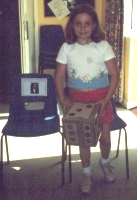 Put a large number of chairs into a square shape with the seats facing inwards. Place cards on the chairs (these are the ones we used). Make a giant dice and a giant coin (we covered a small hoop with cardboard and then drew heads and tails into it). In the centre of the squares place a score board (like this one). The Brownies are the pieces. They take it in turns to roll the dice and move around the board, responding to the cards if there is one on their seat. As they go they will have the opportunity to win or lose points. If they land on a square which is occupied they share the seat. The team who make it to the centre of the score sheet first (or the one with the most points) is the winner. Tudor
Explorers
 The Brownies are
Tudor sailors, setting off to explore the
world. They would particularly like to find the Holy Grail (a special
cup), stories of which have become very popular. The Brownies are
Tudor sailors, setting off to explore the
world. They would particularly like to find the Holy Grail (a special
cup), stories of which have become very popular. Before sailing they must make certain preparations: (1) They must demonstrate 3 sailor's knots. (We used ordinary rope, but if the Brownies are not used to knotting and need a little incentive you can use strawberry amd apple laces.) (2) They must learn the sailor's whistle signals. (We did this through a game. When each signal was given there was an appropriate response.) (3) They must visit the wise woman to help
them map where they should go. (The wise woman gives them a sketched
map showing where each of the islands is, and the obstacles they must
overcome to reach them. Each six is told to visit the islands in a
different order.)
 Obstacle A: A rocky
channel. The
Brownies must navigate their boat (a large piece of cardboard) through
the maze of rocks (chairs). Obstacle A: A rocky
channel. The
Brownies must navigate their boat (a large piece of cardboard) through
the maze of rocks (chairs). 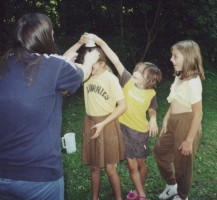 Island A: They
arrive on this island to
discover the inhabitants are in the middle of a festival. The
Brownies are encouraged to compete in the islands silly contests. (They
stick their heads in flour to get a
maltester, pass cups of water upside down over their head and move peas
using a
straw.) After the festival a villager shows them where a scary dragon
lives. The Brownies throw balls at the dragon to knock it unconscious
and then steal the cup it is guarding. Island A: They
arrive on this island to
discover the inhabitants are in the middle of a festival. The
Brownies are encouraged to compete in the islands silly contests. (They
stick their heads in flour to get a
maltester, pass cups of water upside down over their head and move peas
using a
straw.) After the festival a villager shows them where a scary dragon
lives. The Brownies throw balls at the dragon to knock it unconscious
and then steal the cup it is guarding.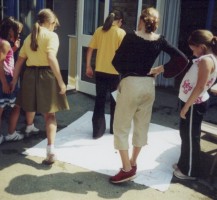 Obstacle B: Pirate
Infested waters. A grid is
drawn onto an old sheet. Each square tells the Brownie to go forward,
back, left or right a certain number of squares or tells them they have
been captured by pirates. There is only one correct route across the
sheet. Obstacle B: Pirate
Infested waters. A grid is
drawn onto an old sheet. Each square tells the Brownie to go forward,
back, left or right a certain number of squares or tells them they have
been captured by pirates. There is only one correct route across the
sheet. 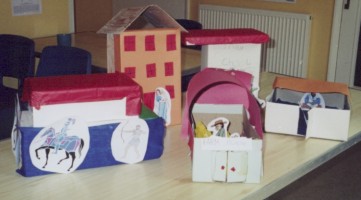 Island B: This is
an island populated by
people about 1 inch tall. They have recently had an earthquake that
destroyed their town. Using 'junk' and their imaginations the Brownies
need to help the villagers restore their town by making two useful
buildings. In thanks the villagers give the Brownies their special cup. Island B: This is
an island populated by
people about 1 inch tall. They have recently had an earthquake that
destroyed their town. Using 'junk' and their imaginations the Brownies
need to help the villagers restore their town by making two useful
buildings. In thanks the villagers give the Brownies their special cup.
 Obstacle C: A sea
monster. The must use fishing rods to
'catch' enough fish to stop the sea monster eating them. Our sea
monster decided to squirt them with water while she waited! Obstacle C: A sea
monster. The must use fishing rods to
'catch' enough fish to stop the sea monster eating them. Our sea
monster decided to squirt them with water while she waited!Island C: This island is unpopulated. Somewhere on the island a cup had been hidden. The Brownies must find it. Island D: This island also has a cup hidden on it, but this time the Brownies must follow the tracking signs to find it. When they have found all four cups they must return to the wise woman, who can tell them which is the real grail. The first team to take the Holy Grail to the King/Queen wins. There are bonus points for any team that brings back something interesting for the King/Queen. Points charts for Pack Holiday
 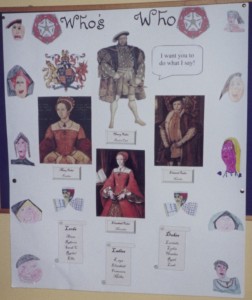 When
we used Henry VIII as a Pack Holiday theme each six designed a crest.
Throughout the weekend they could earn shields when they please Henry
and lose them is they displeased him. When
we used Henry VIII as a Pack Holiday theme each six designed a crest.
Throughout the weekend they could earn shields when they please Henry
and lose them is they displeased him. As well as being kind and helpful, the
Brownies had to stay alert and
do as Henry asked. From time to time a command was listed on the Who's
Who chart. The first people to notice the command could earn shields.
Those who ignored the command were likely to displease Henry and lose
some of their shields.
Throughout the weekend the Brownies had to
stand whenever Henry entered
a room and wait to be given leave to sit. Any Brownies who did not
grovel adequately lost shields. (They really enjoyed sucking up to
Henry - but not as much as Brown Owl enjoyed being Henry!)
Each six had a 'faction' they controlled.
When they earnt shields they
could stick them by the people in their faction. As a six they had to
decide which people to stick their shields next to. If any person in
their faction had all their shields removed that person was executed
and could no longer have shields added to them.
 At the end of the holiday sixes gained one
point for each living member
of their faction and 2 points for any member of their faction who
gained an honour (reached the top of the score chart). There was a
prize for the winning team.
Every Brownie was awarded a parchment
for service to the
King.
Pendants 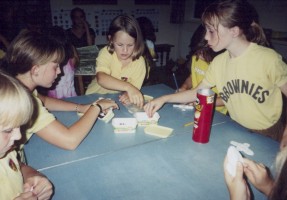 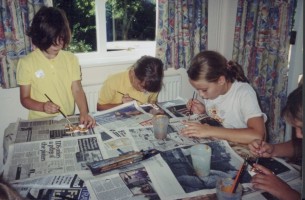 Use clay or model magic to make a cross
shaped pendant. To add jewels push sequins or plastic 'gem' stones into
the clay. Use the end of a thin paintbrush to make a hole in the
pendant. When the clay has dried paint it with gold paint. When the
paint is dry thread gold cord through the hole and fasten it to make a
loose necklace. If your Brownies are really clever you could add beads
to the cord and make a rosary.
Headdress  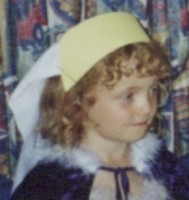 These simple headdresses are made from a
rectangular piece of card and a square of white material. Cut the card
so that it is shaped at the edges (see picture above) and is the
correct length to run from just above one ear to the other. Lie the
card flat on a table and glue a square of white material to it. When
the glue is dry you can attach the headdress using hair grips.
Tudor design sun catchers  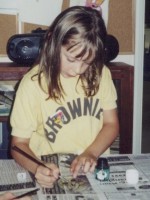 Purchase circle and heart shaped plastic
from a company such as Baker Ross. Prepare outline shapes for the
Brownies to trace such as the Tudor Rose or crests of the Tudor
Monarchs. Many examples of these can be found on the internet (here
for example). The Brownies can then use black glass paint outliners
to draw the outline of their picture. When this is dry they can use
glass paint to finish their design.
Quill pens, black lettering and illuminated manuscripts 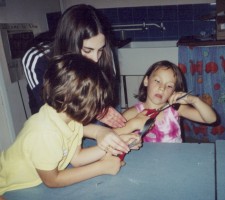  To make a Quill pen, cut the end of a
feather diagonally then make a small, straight, vertical snip into the
cut edge. You can then dip the nib into ink and write with your pen.
The Brownies copied the Black lettering from a children's history book.
These are the letters we printed off for the Brownies to decorate. There is only one letter per page to allow room for the black lettering to decorate the rest of the page. This file only contains the initials of the girls who took part in the activity, but you can create more by downloading the letters from Microsoft Clipart. You then set the image colour to grayscale and then washout. Alternatively you can purchase illuminated letters from many English Heritage/National Trust properties, but they tend to be rather expensive and extremely detailed (which means they take a very long time to colour). Tudor bread and butter 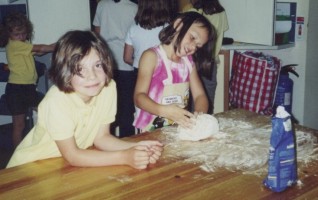  The Brownies could make Tudor style rolls (I
will add the recipe we used when I can locate it) and butter. To make
the butter put a small amount of cream into a container and get the
Brownies to shake it until a large percentage of it has solidified.
Drain off the rest of the cream and you have your butter.
Marchpain and Banquet 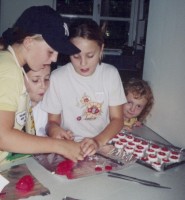 To make the
marchpain take a
block of white marzipan and colour half of it red. Use a sweet sized
cutter to cut red and white flowers and put them together to make
little Tudor roses. To make the
marchpain take a
block of white marzipan and colour half of it red. Use a sweet sized
cutter to cut red and white flowers and put them together to make
little Tudor roses.Banquet is the circular flat sugary sweet served at the end of a feast. It you are very rich you would coat the banquet in gold and make an impression of your seal in it. The Brownies can make their own banquet by placing a boiled sweet on top of silver foil and then melting it in the oven. When the sugar has cooled it will set into a flat circle that can be peeled off. The Brownies could push something into the sugar whilst cooling to make their seal - but becareful, it is VERY hot! Tudor Feast 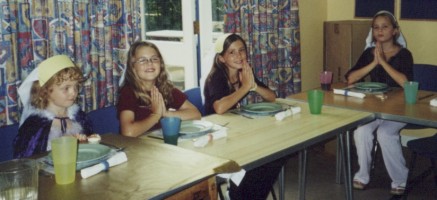 If you don't think that peacock, eel and loach would go down very well your actual food may need to be a little more modern, but you can still create the atmosphere of a tudor feast. The Brownies could prepare table decorations (a pretend peacock or stuffed pig for example). You could display a poster listing some Tudor table manners:
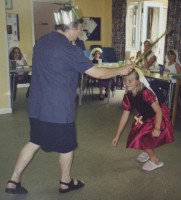 The
feast could be held in honour
of one or two Brownies who have been knighted for some good deed. You
could hold a knighting ceremony at the start of the feast. The
feast could be held in honour
of one or two Brownies who have been knighted for some good deed. You
could hold a knighting ceremony at the start of the feast. If you want to be authentic the girls should not use a fork but a knife and their fingers. If they are very rich you can let them use their own plate and cup - otherwise they would need to share or eat from a trencher (a thick piece of unleavened bread)! You could also:
 Tudor dancing
Make a tape of suitable tudor music (two or three tunes is probably enough). We purchased 'Music from the time of Henry VIII' from English Heritage (at a cost of £2.99), but you can probably find something similar at a local library. We borrowed a book on Tudor dance and some films set in this period that showed the characters dancing. We then adapted the movements to fit the music we had.  Tudor plays
Prepare short tudor plays. We edited sections of the witches speeches
from Shakepeares Macbeth and gave one to each six. An adult was on hand
to help explain any words they did not understand, and some suitable
props were made available. |
|